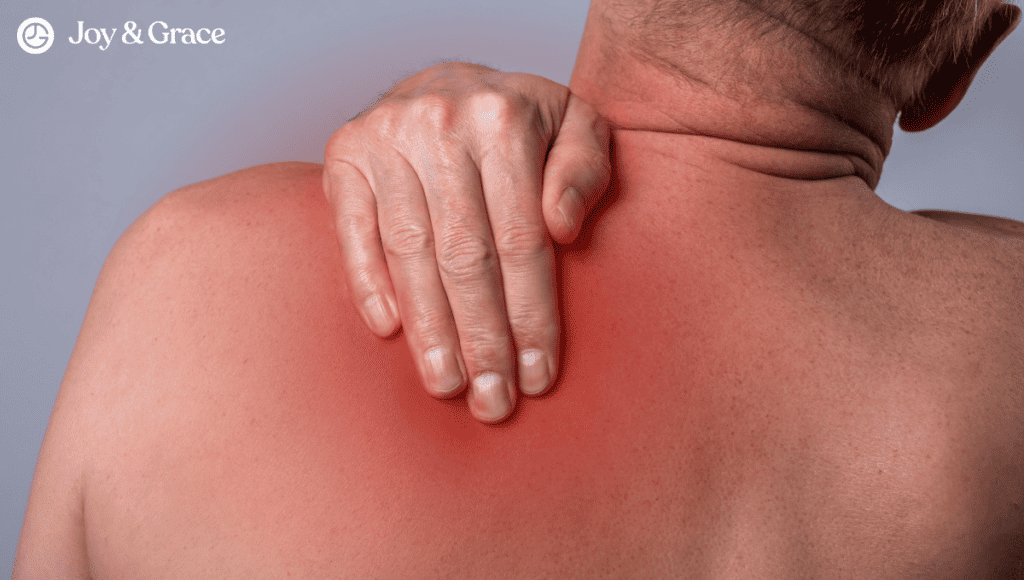Are you experiencing pain on the right side of your neck? Have you wondered if it may have something to do with your thyroid gland? Your intuition might be correct. Thyroid problems are common, and they are known to cause neck pain. They may result from various causes. How can you pinpoint the issue in your case, and what can you do about it?
Read on for causes, symptoms, and relief.
Can Thyroid Disease Cause Pain on One Side of the Neck?
To answer from the beginning, yes. Thyroid disease may indeed affect one or both sides of the neck—both right and left.
To understand why this happens, we first need to discuss the thyroid gland itself. Let’s start with a good old (and brief) talk about the anatomy and pathophysiology of the thyroid and move on from there.
Understanding Thyroid Pain on the Right Side of the Neck
Have you ever asked yourself, “Is my thyroid on the left or right side of my neck?”
Well, the answer is both! The thyroid gland is a smallish, butterfly-shaped gland in the center of the neck.
When we say it’s central, we mean it! The thyroid spans over the right and left sides of the front part of the neck, just above the collarbones. It’s a neighbor to many key neck structures, including nerves, blood vessels, lymph nodes, and other organs.
The thyroid produces hormones of vital importance to the body. These hormones have crucial roles in development, growth, and metabolism.
If the thyroid gets sick, its shape and function change. As a consequence of these changes, neck pain, along with many other symptoms, may appear. What may bring about thyroid disease and its associated neck pain, then? Let’s read on to find out.
Where is Thyroid Neck Pain Located?
Because of the location of the thyroid gland, thyroid neck pain is usually located in the frontal, central part of the neck. Depending on the type and progression of thyroid disease, thyroid neck pain can also appear on the right and left sides of the neck.
If you’re experiencing pain in the back of your neck, though, you might consider looking elsewhere! Pain in the back part of the neck more often means you’re dealing with a muscular or neurological problem.
What Causes Thyroid Neck Pain on the Right Side?
Thyroid disorders (and their associated symptoms like neck pain) come in various forms. They may be autoimmune, resulting from the body attacking the thyroid by mistake.
In other cases, they may involve inflammation of the gland (such as during some infections).
In rarer cases, they may appear as a more serious problem, like cancer. However, neck pain usually appears in more advanced stages of the disease.
The most common thyroid diseases that may cause neck pain on the right (and left) side can be grouped as follows:
- Thyroiditis. Thyroiditis means thyroid gland inflammation. There are many types of thyroiditis. They can cause over- or underproduction of hormones and neck pain.
- Goiter (Enlargement of the thyroid gland). Thyroid gland enlargement usually happens because of iodine deficiency. For most people, goiter is painless. However, in some cases, an enlarged thyroid can cause neck pain and discomfort.
- Thyroid tumors and cancer. Tumor growths may come in the form of adenomas or nodules. These are non-cancerous lump structures that can produce thyroid hormones and cause pain. On the other hand, thyroid cancer happens more rarely and requires treatment. Thyroid cancer can cause neck pain, but it is usually not a presenting symptom of the disease. We’ll touch on this a bit later as well. (Can Thyroid cancer cause shoulder pain? Article here.)
There are two main reasons why thyroid disease may manifest as neck pain:
- Thyroid disease may cause inflammation. Due to various reasons (such as infection, trauma, or radiation), the thyroid may become inflamed. Thyroid inflammation damages the thyroid cells, triggering a neck pain reaction.
- Thyroid nodules or enlargement may compress other structures. Thyroid nodules are small growths of thyroid tissue that can cause compression pain. Similarly, an enlarged thyroid may push around and compress the surrounding nerves and organs. The compression of other neck structures may lead to neck tightness and discomfort.
Thyroid diseases also affect thyroid functions. As a consequence, hormone production changes may appear as one of the following:
- Hypothyroidism (The underproduction of thyroid hormones), and
- Hyperthyroidism (The overproduction of thyroid hormones).
These two are usually, but not always, autoimmune.
Note: These disorder groups aren’t necessarily separate entities. They may occur at the same time or overlap.
Now that we've discovered the thyroid neck pain culprits, let’s pick them apart one by one.
1. Thyroiditis Neck Pain
As with most medical terms ending in ”-itis,” thyroiditis involves inflammation. Thyroiditis happens when thyroid cells get inflamed and hurt. As a result, neck pain may occur. Thyroiditis is associated with either thyroid hormone overproduction or underproduction.
Thyroiditis can be divided into a few types, as follows:
- Subacute (or De Quervain’s) thyroiditis. Subacute thyroiditis usually happens after a viral infection. It’s characterized by neck pain, difficulty swallowing, and a history of a viral infection. More often than not, it goes away on its own.
- Drug-induced thyroiditis. Thyroiditis may result from drug use as well. Here we can mention lithium (used for bipolar disorder) and interferons (used for cancer treatment). These drugs may damage the thyroid gland, causing an inflammatory response. This response manifests as neck pain, among other symptoms.
- Radiation-induced thyroiditis. This type can happen after ingesting radioiodine or after undergoing external radiation. Neck pain and a tender goiter are its defining features. It’s usually self-limited, which means it resolves itself.
- Infectious thyroiditis. Infectious thyroiditis occurs due to bacterial infections (most commonly S. aureus and Strep species). It’s characterized by a sudden onset of (mostly one-sided) neck pain, swelling, tenderness, and difficulty swallowing. These symptoms also combine with infectious symptoms such as fever, chills, and lymph node enlargement. Without treatment, infectious thyroiditis may cause permanent destruction of the thyroid. It may also spread to the blood and cause sepsis. Hence, antibiotics are necessary.
- Palpation thyroiditis. Repeatedly touching or examining the thyroid can inflame it, causing neck pain. Yep, you read that right—leave the examinations to the professionals!
Thyroiditis Types Which Do NOT Cause Neck Pain
The list of thyroiditis types goes on! But there’s a key difference between them. The types we listed above cause neck pain. The ones mentioned below are typically painless and include the following:
- Hashimoto’s thyroiditis. This is the most common type of thyroiditis. It’s characterized by painless enlargement of the thyroid gland. Hashimoto’s thyroiditis is an autoimmune disease. It may be associated with hypothyroidism (and a transient period of hyperthyroidism).
- Post-partum thyroiditis. As the name suggests, post-partum thyroiditis happens within six months of giving birth. It’s autoimmune, painless, and associated with type 1 diabetes. If you’ve had post-partum thyroiditis, there’s a 70% chance it might recur after giving birth again.
- Silent (Painless) thyroiditis. This type of thyroiditis is similar to post-partum thyroiditis, except that it’s unrelated to pregnancy.
2. Goiter: On What Side Does the Thyroid Swell
The thyroid gland can swell on both sides of the neck. As mentioned, thyroid enlargement is also known as goiter. A simple goiter is not a tumor or cancer. It most commonly happens when your body doesn’t have enough iodine. Iodine is an essential component in producing thyroid hormones. When there’s insufficient iodine, the thyroid gland tries to make itself as big as possible to absorb all the available iodine and produce hormones.
Iodine deficiency occurs due to inadequate consumption of iodine-rich foods (ionized salt, dairy, fish, etc.).
Goiter may also arise from the following causes:
- Autoimmune conditions (which can cause both hypo- or hyperthyroidism)
- Medications such as amiodarone and lithium
- Smoking cigars
- Diet variations, like eating too much soy, peanuts, cabbage, and broccoli
- Infections
- Formation of nodules. As said, these are abnormal, toxic growths that give the thyroid an irregular, lumpy appearance.
A small goiter is usually painless. Even though it might be visible under the skin, it might not cause any symptoms at all.
A much-bigger-than-normal thyroid gland can be problematic, though. If it grows too much, the thyroid may fill up spaces it doesn’t belong to, potentially causing the following symptoms:
- Neck discomfort and tightness, which may be interpreted as pain
- Airway obstruction from compression of the trachea (windpipe). The obstruction may result in choking, coughing, and breathlessness.
- Voice changes. Hoarseness may occur because of laryngeal nerve compression.
- Difficulty swallowing. This occurs after esophageal compression.
- Horner’s syndrome. Horner’s syndrome is marked by pupil changes, eyelid drooping, and sweating. It may appear from the compression of the sympathetic nerve chain in the neck.
- Circulation problems. Circulation changes may arise from neck artery compression and jugular vein compression.
3. Thyroid Tumors: How Do You Know if Neck Pain is Cancer?
While it's true that neck pain can be a sign of cancer, this is actually quite uncommon.
Pain in a palpable body area, such as the neck, may fill you with all kinds of thoughts. The moment pain kicks in, worries about potentially having cancer naturally pop up.
However, it’s important to remember that thyroid pain doesn’t mean cancer by default (in fact, it rarely does).
So, how can you tell the difference between usual and cancer-related neck pain?
Other symptoms are frequently present with thyroid cancer-related neck pain. They include the following:
- A lump in the neck, which sometimes grows quickly.
Lumps in the neck should be monitored. Lumps caused by overgrowth of cells in the thyroid gland are known as thyroid nodules. They may signal the beginning of cancerous growth.
Much more commonly, though, they’re benign (non-cancerous) nodules. One example of benign nodules is thyroid adenomas. Cancerous and non-cancerous nodules (such as adenomas) are not the same.
Adenomas are benign, overgrown thyroid tissues. They can appear as painless lumps during physical examination or imaging. Adenomas usually don’t cause symptoms.
Nodules are usually found incidentally during imaging tests. This is proof of the importance of screening tests. If you have neck pain but no nodules on imaging, you most probably don’t have thyroid cancer.
- Swelling in the neck
- A hoarse voice or other voice changes that do not go away
- Trouble swallowing
- Trouble breathing
- A persistent cough that is not due to a cold
- Unexplained Weight Loss
If these signs seem familiar, don’t ignore them or try to self-diagnose. Instead, reach out to your healthcare provider for a professional evaluation.
What Part of the Neck Hurts With Thyroid Cancer?
The front of the neck, near the location of the neck lump, is typically where thyroid cancer causes neck pain. The pain may also spread to the ears and jaw.
If it’s very advanced, thyroid cancer may metastasize or spread to other body areas. Late-stage thyroid cancer tends to spread to the vertebrae, potentially causing back pain. Thankfully, metastasis and back pain are rare, as thyroid cancer generally responds well to treatment.
As we mentioned earlier: Thyroid cancer can cause neck pain, but it is usually not a presenting symptom of the disease.
Additionally, it is reported mainly in advanced disease and not as an isolated finding (neck pain only).
The most common presenting feature of thyroid cancer is either neck swelling or incidentally detected thyroid nodules on imaging.
How Long Does Thyroid Neck Pain Last?
Thyroid neck pain lasts as long as you don’t treat the underlying cause of the pain. Many thyroid conditions may become chronic without treatment, potentially leading to harmful consequences.
Hence, address your complaints and seek medical care early. An early and accurate diagnosis and management of thyroid disorders can:
- Ease neck pain,
- Normalize thyroid hormone imbalances, and
- Improve life quality.
What Causes Pain on the Left Side of the Neck?
Thyroid pain on the left side of the neck has the same causes as that on the right. The location of the pain depends on the inflammation site and the neck structures affected.
It's important to know that experiencing neck pain doesn't necessarily mean there's an issue with your thyroid. Neck pain is a common problem worldwide. The most frequent disorders and conditions that cause one-sided (and two-sided) neck pain include the following:
- Weak and overused neck muscles, commonly caused by:
- Poor posture
- Sports and activities that keep your neck in a fixed position, tensing your muscles
- Wear and tear on the cervical spine with age, including:
- Formation of bone growths or spurs
- Osteoarthritis of the neck (Cervical spondylosis)
- Disc weakening and flattening
- Whiplash injury. Whiplash frequently happens during car crashes. It involves a fast back-and-forth neck motion that may severely damage the neck.
- Narrowing of the spinal canals. This can put pressure on the spinal cord and nerves, causing pain and neurological symptoms.
- Herniated intervertebral disc. A herniated disc slips out of its normal position between vertebrae. A herniated disc may also compress nerves, giving rise to pain and neurological symptoms.
Is Thyroid Neck Pain on One Side Serious?
Yes, if you suspect your one-sided neck pain is thyroid-related, it can be a sign of a more serious underlying problem. But pain on one side of the neck is usually not thyroid-related, as mentioned above.
The only way you can be sure is to address your complaint with your healthcare provider.
How Can I Tell if My Right Neck Pain Is From My Thyroid?
Recognizing whether your neck pain is related to your thyroid can be a bit tricky. But we’re here to help! If you think your neck pain is thyroid-related, ask yourself the following questions:
- “Where is my neck pain located?” Thyroid neck pain is located on the frontal neck, with a focus on the center, right, or left.
- “Does my pain go along with other thyroid symptoms?” Remember: thyroid-related neck pain almost never appears alone. It is always associated with any of the other typical symptoms we listed above. These include hormonal changes, swelling, neck lumps, breathing or swallowing changes, etc.
- “Do my ears and jaw hurt?” Thyroid neck pain may spread to the ears and jaw.
- “Have I had a neck injury recently?” Neck injuries may trigger thyroid inflammation (thyroiditis) and cause neck pain.
- “Does my neck pain change when I move my head?” A degenerated disc or a muscle strain might be possible culprits. Thyroid neck pain does not usually change when moving the neck.
- “Do I have a fever, chills, or lymph node enlargement?” These may be signs of a possible infection that may have caused thyroid inflammation.
- “Do I have numbness, weakness, and tingling in my neck, shoulders, arms, and hands?” These might be signs of a neurologic cause of neck pain. They’re not thyroid-related.
Note: These tips are only intended to give you a general idea of your neck pain. It’s crucial to understand that you should not self-diagnose. Only a medical professional should evaluate and diagnose thyroid disorders.
When Should I See a Doctor for Thyroid Neck Pain?
Is this the first time you’ve suspected neck pain from thyroid disease? If yes, don’t hesitate to consult your doctor. We’re very pleased to provide you with the most up-to-date information through our articles. But medical care is irreplaceable. Consulting your doctor will help you manage your symptoms and make you aware of your health and well-being.
You can arrange a check-up with your primary healthcare provider (PCP). A PCP will take your medical history and perform a physical exam of the neck and thyroid. They may then suggest you do some tests (we’ll see them below).
If your PCP considers a potential thyroid-related cause for your neck pain, they may refer you to an endocrinologist. An endocrinologist is a medical specialist who deals with endocrine or hormonal disorders. These also include thyroid disorders.
If you’ve had your thyroid symptoms for a while, check up on them. We’d recommend you pay a visit to your doctor if your neck pain and other thyroid-related symptoms:
- Change,
- Become worse, or
- Don’t improve despite therapy.
What Tests Diagnose Thyroid Neck Pain
The most practical and effective tests for thyroid neck pain include the following:
- Blood tests. Your doctor will want to see your thyroid hormone levels. A hormonal blood test may show overproduction or underproduction of hormones.
- Ultrasound. An ultrasound exam is the go-to exam for the thyroid gland. It’s easy and quick to perform and doesn’t cause discomfort. Ultrasound imaging can visualize the thyroid, including any potential nodules or mysterious growths.
- Thyroid scan and uptake. This test is used to mark any possible cancerous signs in the thyroid area.
- Biopsy. A biopsy involves taking a sample of thyroid tissue and analyzing it. A biopsy is performed after an ultrasound and thyroid scan to assess the possibility of thyroid cancer.
- Neck movement tests. Your doctor may perform additional examinations to rule out other causes of neck pain. These tests check the neck's range of motion and intend to provoke reactions from certain movements.
- X-ray, CT scan, or MRI. These are all imaging tests that may be used to rule out other potential causes of neck pain.
How is Thyroid Neck Pain Treated?
Thyroid-related neck pain can be distressing. But rest assured, the good news is that thyroid neck pain can be successfully treated. There are numerous options available to relieve discomfort. Whether it's on the right or left side of your neck, adequate treatment will depend on the underlying cause of the pain
The management plan for thyroid neck pain may involve the following measures:
- Managing inflammation and pain with anti-inflammatory medications (like NSAIDs)
- Managing hormonal changes. Hormone replacement therapy is indicated when there’s hypothyroidism (underproduction of hormones). If there’s overproduction, beta-blockers may be necessary to control the symptoms. (mostly to slow the heart rate and decrease nervousness)
- Managing infections. Bacterial infections may precipitate thyroiditis. Antibiotics and supportive care may be required.
- Re-evaluating therapy. Medications used for other purposes that damage the thyroid must be stopped.
- Eliminating cancerous growths or a toxic goiter. If thyroid cancer is suspected, your doctor might recommend the following options:
- Monitoring symptoms and changes. Regular checkups are crucial in the long-term management of thyroid disease.
Takeaway
Thyroid disease may affect one or both sides of the neck - the right and the left.
Thyroid neck pain is usually located in the frontal, central part of the neck. Depending on the type of thyroid disease and how it develops, thyroid neck pain often appears on the right and left sides of the neck.
The most common thyroid diseases that may cause neck pain on the right side can be grouped as follows:
- Thyroiditis (Thyroid gland inflammation)
- Goiter (Enlargement of the thyroid gland)
- Thyroid tumors and cancer
There are two main reasons why thyroid disease may manifest as neck pain:
- Thyroid disease may cause inflammation.
- Thyroid nodules or enlargement may compress other structures.
The most common symptoms of thyroid cancer may include the following:
- Neck pain
- A lump in the neck, which sometimes grows quickly.
- Swelling in the neck
- Hoarseness or other voice changes that do not go away
- Trouble swallowing
- Trouble breathing
- A persistent cough that is not due to a cold
The management plan for thyroid neck pain involves the following measures:
- Managing inflammation and pain with anti-inflammatory medications (like NSAIDs)
- Managing hormonal changes. Hormone replacement therapy is indicated in hypothyroid states. Beta-blockers may be necessary to control hyperthyroid states.
- Managing infections.
- Re-evaluating therapy. Medications used for other purposes that damage the thyroid must be stopped.
- Eliminating cancerous growths or a toxic goiter. If thyroid cancer is suspected, your doctor might recommend the following options:
- Surgical removal of the thyroid gland
- Radiation therapy
- Anti-thyroid drugs
- Monitoring symptoms and changes
Consulting your doctor early will help you manage your symptoms and improve your health and well-being.















